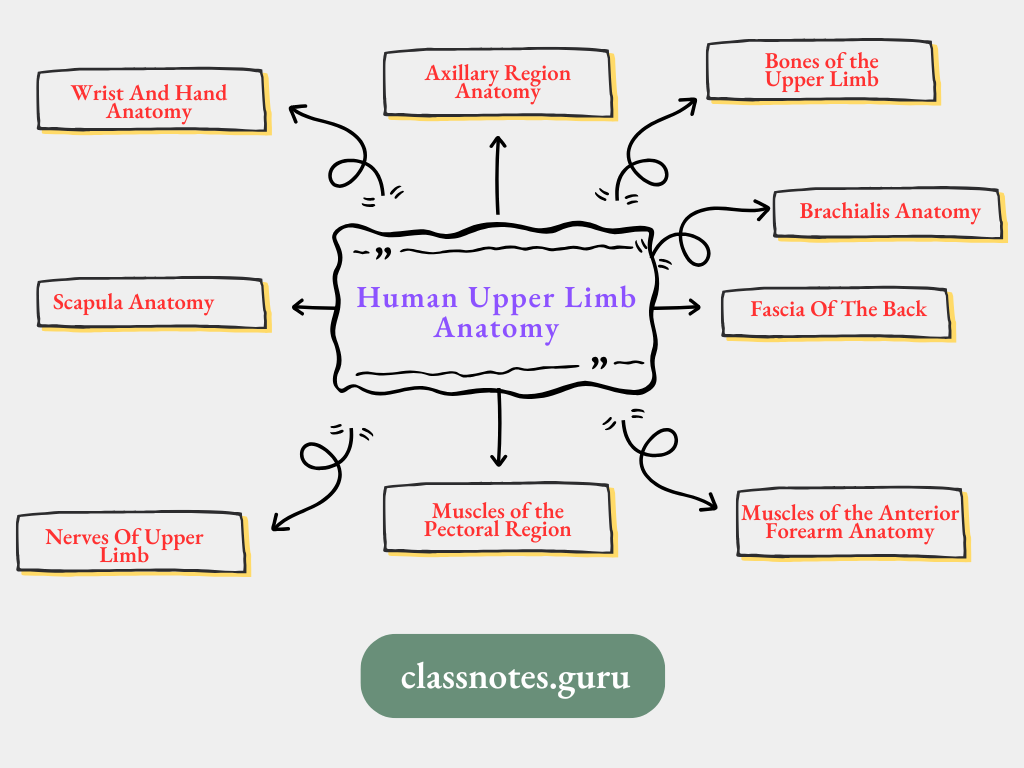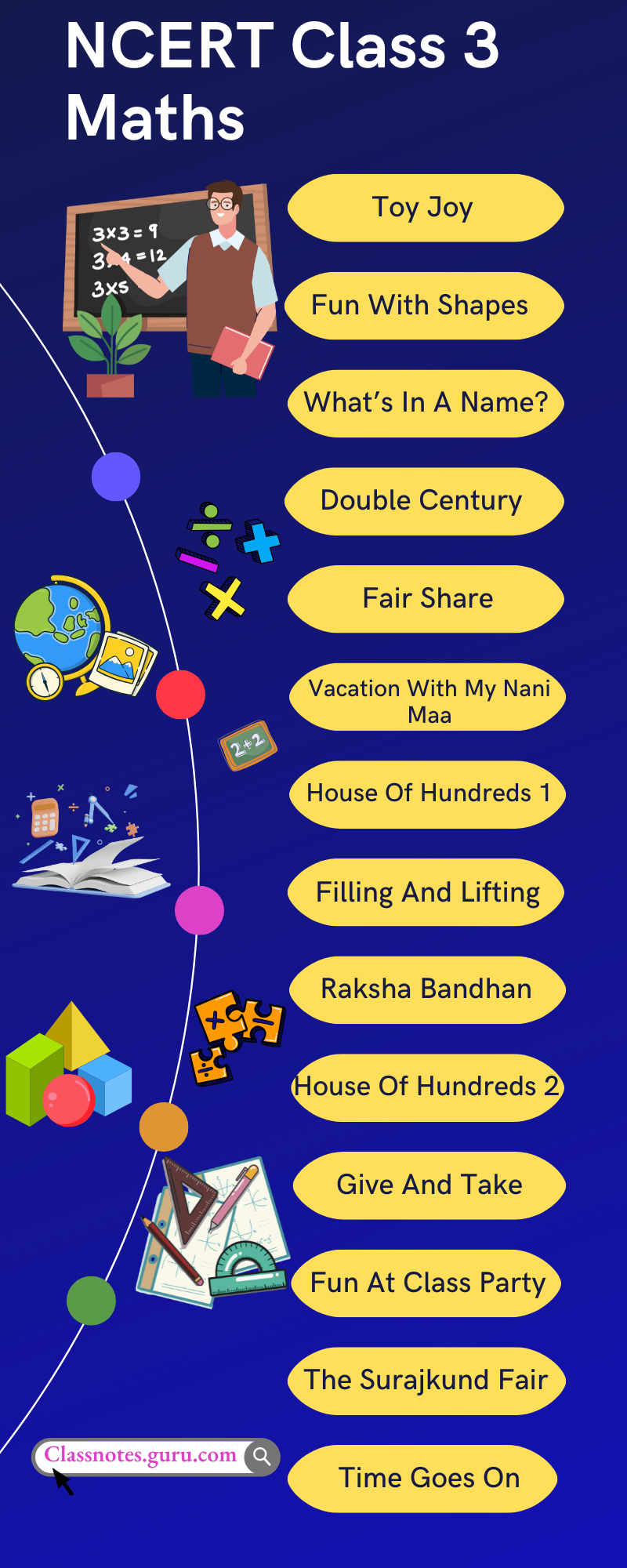Extent, Formation, And Contents Of Anterior Abdominal Wall
Firm and elastic wall
Anterior Abdominal Wall Extent:
- Superiorly from the costal margin and xiphoid process
- Inferiorly up to the iliac crest and pubic symphysis
Read And Learn More: Abdomen And Pelvis
The anterior abdominal wall is made up of 8 layers. They are:

- Deep fascia is absent in the anterior abdominal wall, which allows the abdomen to distend during pregnancy or after meals.
1. Umbilicus
- Umbilicus is a normal scar in the anterior abdominal wall, representing the site of attachment of root of the umbilical cord
- The position of the umbilicus is variable
- In most cases:
- Adults: Lies a little below the midpoint of the linea alba
- New-born: Slightly lower
- Old age: Lower due to decreased tone of abdominal muscles.
Anatomy Of Anterior Abdominal Wall
Importance of Umbilicus
- Umbilicus act as an important anatomical and embryological landmark
- Anatomically:
- Watershed line: Venous and lymphatic flow is directed away from the umbilicus (directed upwards above the umbilicus and directed downwards below the umbilicus)
- Umbilicus is a site of portocaval anastomosis
- Skin around the umbilicus comes under the T10 dermatome.
- Embryologically:
- It is the meeting point of four folds of the embryonic plate:
- Head
- Two lateral plates
- Tail
- It is the meeting point of three systems in fetal life, they are:
- Umbilical vessel (vascular system)
- Vitello intestinal duct (digestive system)
- Urachus (excretory system).
2. Superficial Fascia
- Made of layers of fat, more at the lower half
- Above the level of the umbilicus, the superficial fascia is made up of a single layer of fat
- Below this level, it is made up of two layers, namely:
- Camper’s fascia: Superficial fatty layer
- Scarpas fascia: Deep membranous layer.
Camper’s Fascia
- Superficial fatty layer
- It is continuous with superficial fascia with adjoining parts of the body
- Over the penis: It is devoid of fat
- Over scrotum: It is replaced by dartos muscle.
Scarpas Fascia
- Deep membranous layer
- Made up of elastic type of fibrous tissue
- It is continuous below with another membranous layer of the superficial fascia of the perineum, called the Colle’s fascia
Scarpas Fascia Attachments
- Midline: Linea alba
- Each side: It is separated from external oblique muscles by a layer of loose areolar tissue
- Inferiorly: Attached to fascia lata of thigh (this line of attachment is surface marked by Holden’s line)
- It encloses the penis up to the base of glans
- In the scrotum, it is replaced by dartos muscle.
Anterior Abdominal Wall Layers
Muscles of Anterior Abdominal Wall

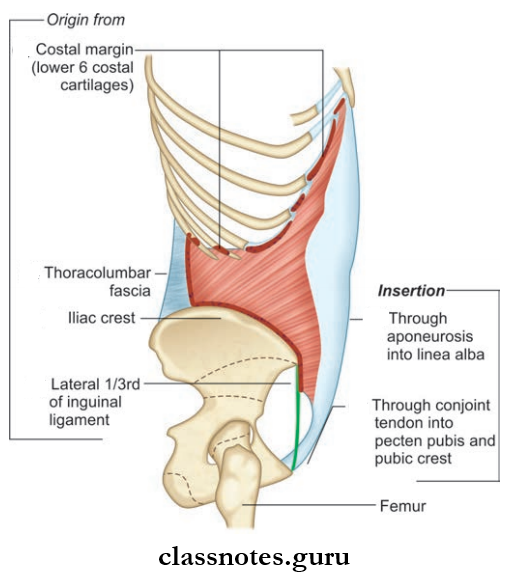
Flat Muscles Of Anterior Abdominal Wall

- Anterior Abdominal Wall Muscle
- External oblique muscle
- Internal oblique muscles
- Transversus abdominis muscle
- Anterior Abdominal Wall Nerve supply
- Lower six thoracic nerves (T7–T12) and fist lumbar (L1) nerve
- Internal oblique muscles
- Transversus abdominis muscle
- Anterior Abdominal Wall Blood Supply
- Blood supply of all felt muscles of anterior abdominal wall is from same source, they are:
- Lower posterior intercostal arteries
- Subcostal arteries
- Superior and inferior epigastric arteries
- Superfiial and deep circumflx arteries
- Posterior lumbar artery.
Anterior Abdominal Wall Muscles
Three important structures are formed by the above-mentioned felt muscles of the anterior abdominal wall, namely:
- Inguinal ligament
- Conjoint tendon
- Cremaster muscle.
Out of which, inguinal ligament and conjoint tendon are explained in detail:
1. Anterior Abdominal Wall Inguinal ligament
- Thick fibrous band, lying beneath the fold of the groin
- Derived from the lower free border of the external oblique aponeurosis
- Extend: Anterior superior iliac spine to pubic tubercle
- The lower border of the inguinal ligament is attached to the fascia lata (deep fascia of thigh)
- Traction by this fascia pulls the inguinal ligament convex downwards.
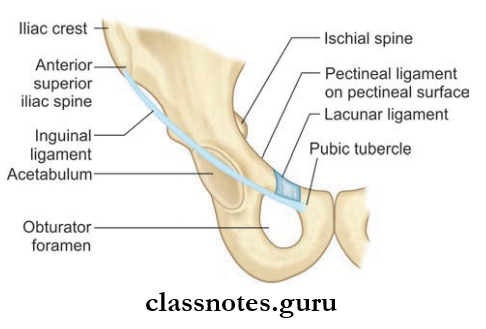
Extensions of Inguinal ligament
- Lacunar ligament:
- Triangular in shape
- Apex attached to pubic tubercle
- Base directed laterally
- Lacunar Ligament Attachments
- Anteriorly: Medial end of inguinal ligament
- Posteriorly: Pecten pubis.
- Pectineal ligament:
- It is the extension of posterior part of the lacunar ligament
- Considered as a thickening in the upper part of the pectineal fascia.
- Reflcted part of inguinal ligament:
- Formed by superficial fibers from the medial end of the inguinal ligament passing upwards and medially
- These fiers intermix with those of opposite side at the line alba
- It lies behind the superficial inguinal ring.
Anterior Abdominal Wall Nerve Supply
- Ilioinguinal ligament: Fibrous band between the inferior surface of the inguinal ligament to iliopectineal eminence.
2. Conjoint tendon
- Also known as falx inguinalis
- Formation: By the fusion of lower aponeurotic fibers of internal oblique and transversus abdominis muscle
- It has attachments to the pubic crest and medial part of the pecten pubis
- It forms the medial half of the posterior wall of the inguinal canal
- Medially it is continuous with the anterior wall of the rectus sheath
- Laterally it is usually free, but sometimes may be continuous with the interfoveolar ligament.
Conjoint Tendon Applied Anatomy
The portion of the abdominal wall which is weakened due to the presence of superficial inguinal ring is strengthened by the conjoint tendon.
Vertical Muscles of Anterior Abdominal Wall
1. Rectus Abdominis Muscle
- One of the two vertical muscles of anterior abdominal wall, the other being pyramidalis
- Extend: From the costal margin to the pubic symphysis along the linea alba
- It narrows as it descends downwards (wider above and narrow below)
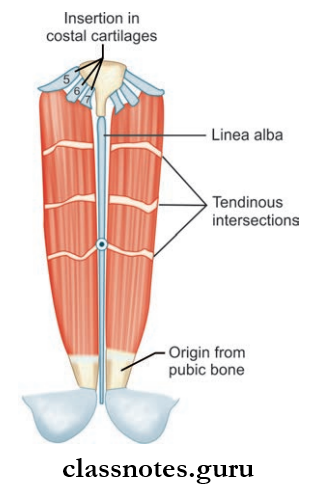
Rectus Abdominis Muscle Origin: From two tendinous heads—lateral and medial
- Lateral head: From the lateral part of pubic crest and pubic tubercle
- Medial head: From the anterior pubic ligament
Rectus Abdominis Muscle Insertion:
- Inserted through 4 flashy slips
- These fleshy slips gets inserted along a horizontal line passing from lateral to medial on the 7th, 6th, 5th costal cartilages and xiphoid process
Rectus Abdominis Muscle Actions: Flexes the trunk, supports the abdominal viscera
Rectus Abdominis Muscle Nerve supply: T7–T12 thoracic nerves
Rectus Abdominis Muscle Blood supply: Superior and Inferior epigastric arteries.
Anterior Abdominal Wall Blood Supply
Pyramidalis Muscle
- Triangular muscle
- Base of the triangle forms the origin and the apex forms the insertional part of the muscle
- Lies in front of the lower part of rectus abdominis
- It is covered by rectus sheath
Pyramidalis Muscle Origin: From the front of the pubis and pubic symphysis
Pyramidalis Muscle Insertion:
- Attached medially to the linea alba
- Point of attachment lies midway between the umbilicus and pubic symphysis
Pyramidalis Muscle Actions: Tenses the lower linea alba
Pyramidalis Muscle Nerve supply: Subcostal nerve
Pyramidalis Muscle Blood supply: Inferior epigastric artery, deep circumflex iliac artery.




